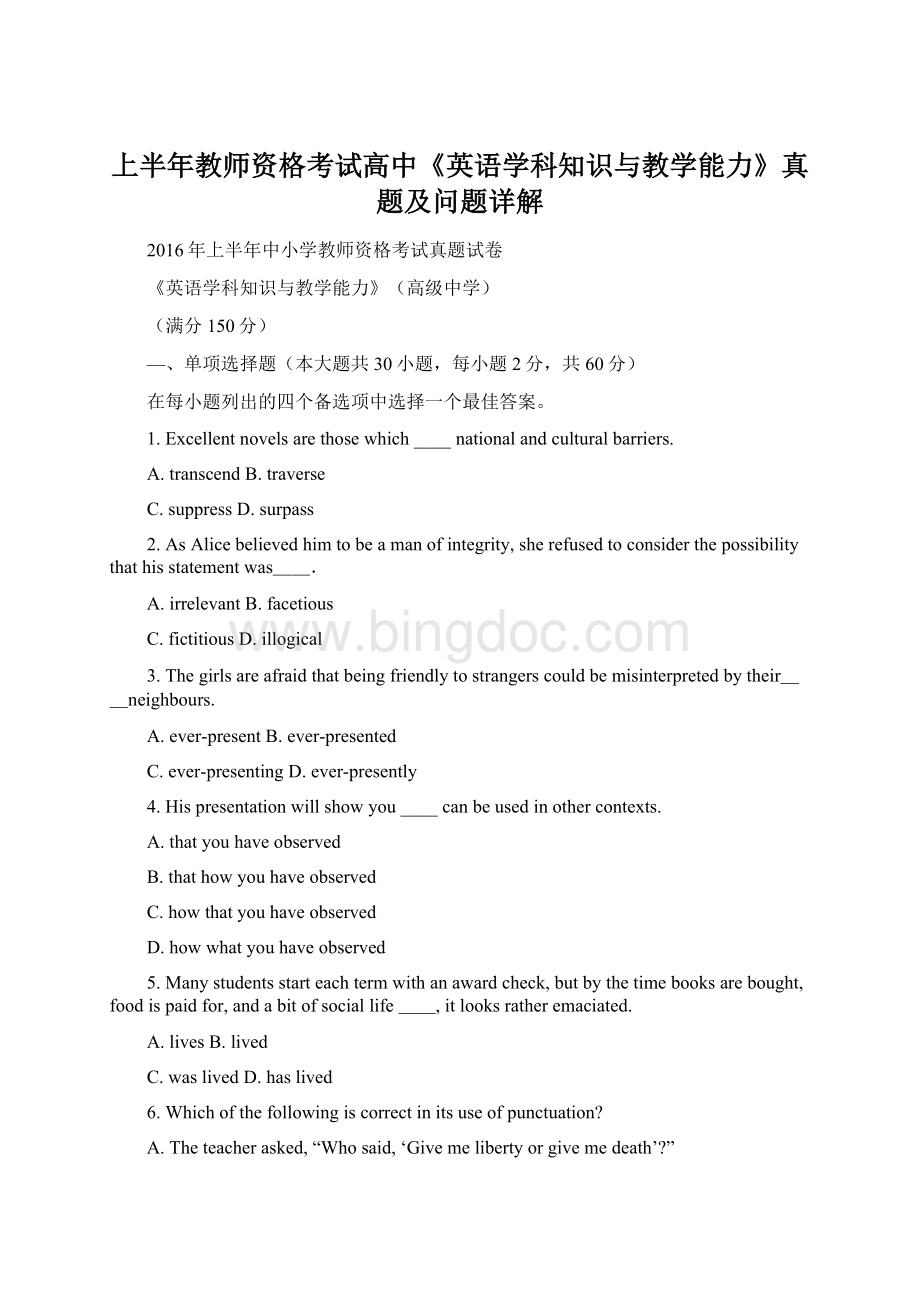上半年教师资格考试高中《英语学科知识与教学能力》真题及问题详解.docx
《上半年教师资格考试高中《英语学科知识与教学能力》真题及问题详解.docx》由会员分享,可在线阅读,更多相关《上半年教师资格考试高中《英语学科知识与教学能力》真题及问题详解.docx(10页珍藏版)》请在冰点文库上搜索。

上半年教师资格考试高中《英语学科知识与教学能力》真题及问题详解
2016年上半年中小学教师资格考试真题试卷
《英语学科知识与教学能力》(高级中学)
(满分150分)
—、单项选择题(本大题共30小题,每小题2分,共60分)
在每小题列出的四个备选项中选择一个最佳答案。
1.Excellentnovelsarethosewhich____nationalandculturalbarriers.
A.transcendB.traverse
C.suppressD.surpass
2.AsAlicebelievedhimtobeamanofintegrity,sherefusedtoconsiderthepossibilitythathisstatementwas__.
A.irrelevantB.facetious
C.fictitiousD.illogical
3.Thegirlsareafraidthatbeingfriendlytostrangerscouldbemisinterpretedbytheir__neighbours.
A.ever-presentB.ever-presented
C.ever-presentingD.ever-presently
4.Hispresentationwillshowyou____canbeusedinothercontexts.
A.thatyouhaveobserved
B.thathowyouhaveobserved
C.howthatyouhaveobserved
D.howwhatyouhaveobserved
5.Manystudentsstarteachtermwithanawardcheck,butbythetimebooksarebought,foodispaidfor,andabitofsociallife__,itlooksratheremaciated.
A.livesB.lived
C.waslivedD.haslived
6.Whichofthefollowingiscorrectinitsuseofpunctuation?
A.Theteacherasked,“Whosaid,‘Givemelibertyorgivemedeath’?
”
B.Theteacherasked,“Whosaid,‘Givemelibertyorgivemedeath?
’”
C.Theteacherasked,“Whosaid‘Givemelibertyorgivemedeath’”?
D.Theteacherasked,“Whosaid‘Givemelibertyorgivemedeath’?
”
7.ThepairofEnglishphonemes_differintheplaceofarticulation.
A./ʃ/and/ʒ/
B./θ/and/ð/
C./d/and/z/
D./m/and/n/
8.Thereare_consonantclustersinthesentence“Brian,Iappreciatebeautifulscarfyoubroughtme.”
A.twoB.three
C.fourD.five
9.Whensaying“It’snoisyoutside”togetsomeonetoclosethewindow,thespeakerintendstoperforma(n)_.
A.directspeechact
B.locutionaryact
C.indirectspeechact
D.perlocutionaryact
10.ThataJapanesechildadoptedatbirthbyanAmericancouplewillgrowupspeakingEnglishindicates_ofhumanlanguage.
A.dualityB.culturaltransmission
C.arbitrarinessD.cognitivecreativity
11.Fluentandappropriatelanguageuserequiresknowledgeof_andthissuggests
thatweshouldteachlexicalchunksratherthansinglewords.
A.denotationB.connotation
C.morphologyD.collocation
12.“Underliningallthepastformverbsinthedialogue”isatypicalexercisefocusingon_.
A.useB.form
C.meaningD.function
13.Whichofthefollowingactivitiesmaybemoreappropriatetohelpstudentspracticeanewstructureimmediatelyafterpresentationinclass?
A.Roleplay.
B.Groupdiscussion.
C.Patterndrill.
D.Writtenhomework.
14.Whenteachingstudentshowtogiveappropriateresponsestoacongratulationoranapology,theteacherisprobablyteachingat_.
A.lexicallevel
B.sentencelevel
C.grammaticallevel
D.discourselevel
15.Whichofthefollowingactivitiescanhelpdeveloptheskilloflisteningforgist?
A.ListenandfindoutwhereJimlives.
B.Listenanddecideonthebesttitleforthepassage.
C.Listenandunderlinethewordsthespeakerstresses.
D.Listentopairsofwordsandtelliftheyarethesame.
16.WhenanEFLteacheraskshisstudent“Howdoyouknowthattheauthorlikedtheplacesincehedidnottellusexplicitly?
”,he/sheishelpingstudentstoreach_comprehension.
A.literal
B.appreciative
C.inferential
D.evaluative
17.Whichofthefollowingtypesofquestionsaremostlyusedforcheckingliteralcomprehensionofthetext?
A.Displayquestions.
B.Rhetoricalquestions.
C.Evaluationquestions.
D.Referentialquestions.
18.Whichofthefollowingisatypicalfeatureofinformalwriting?
A.Awell-organizedstructureispreferred.
B.Shortandincompletesentencesarecommon.
C.Technicaltermsanddefinitionsarerequired.
D.Awiderangeofvocabularyandstructuralpatternsareused.
19.Peer-editingduringclassisanimportantstepofthe_approachtoteachingwriting.
A.genre-based
B.content-based
C.process-oriented
D.product-oriented
20.Portfolios,dailyreportsandspeechdeliveringaretypicalmeansof_.
A.norm-referencedtest
B.criterion-referencedtest
C.summativeassessment
D.formativeassessment
请阅读Passagel,完成第21~25小题。
Passagel.
WhentheViaductdeMillauopenedinthesouthofFrancein2004,thistallestbridgeintheworldwonworldwideaccolades.Germannewspapersdescribedhowit“floatedabovetheclouds”with“eleganceandlightness”and“breathtaking”beauty.InFrance,paperspraisedthe“immense”“concretegiant.”WasitmerecoincidencethattheGermanssawbeautywheretheFrenchsawheftandpower?
LeraBorodiskythinksnot.
Inaseriesofcleverexperimentsguidedbypointedquestions,Boroditskyisamassingevidencethat,yes,languageshapesthought.Theeffectispowerfulenough,shesays,that“theprivatementallivesofspeakersofdifferentlanguagesmaydifferdramatically,”notonlywhentheyarethinkinginordertospeak,“butinallmannerofcognitivetasks,”includingbasicsensoryperception.“Evenasmallflukeofgrammar”—thegenderofnouns—“canhaveaneffectonhowpeoplethinkaboutthingsintheworld,”shesays.
Asinthatbridge,inGerman,thenounforbridge,Brucke,isfeminine.InFrench,pontismasculine.Germanspeakerssawprototypicallyfemalefeatures;Frenchspeakers,masculineones.Similarly,Germansdescribekeys(Schlussel)withwordssuchashard,heavy,jagged,andmetal,whiletoSpaniardskeys(llaves)aregolden,intricate,little,andlovely.Guesswhichlanguageconstrueskeyasmasculineandwhichasfeminine?
Grammaticalgenderalsoshapeshowweconstrueabstractions.In85percentofartisticdepictionsofdeathandvictory,forinstance,theideaisrepresentedbyamanifthenounismasculineandawomanifitisfeminine,saysBoroditsky.Germanstendtopaintdeathasmale,andRussianstendtopaintitasfemale.
Languageevenshapeswhatwesee.Peoplehaveabettermemoryforcolorsifdifferentshadeshavedistinctnames—notEnglish’slightblueanddarkblue,forinstance,butRussian’sgoluboyandsinly.Skepticsofthelanguage-shapes-thoughtclaimhavearguedthatthat’satrivialfinding,showingonlythatpeoplerememberwhattheysawinbothavisualformandaverbalone,butnotprovingthattheyactuallyseethehuesdifferently.Inaningeniousexperiment,however,Boroditskyandcolleaguesshowedvolunteersthreecolorswatchesandaskedthemwhichofthebottomtwowasthesameasthetopone.NativeRussianspeakerswerefasterthanEnglishspeakerswhenthecolorshaddistinctnames,suggestingthathavinganameforsomethingallowsyoutoperceiveitmoresharply.Similarly,Koreanusesonewordfor“in”whenoneobjectisinanothersnugly,andadifferentonewhenanobjectisinsomethingloosely.Sureenough,KoreanadultsarebetterthanEnglishspeakersatdistinguishingtightfitfromloosefit.
Sciencehasonlyscratchedthesurfaceofhowlanguageaffectsthought.InRussian,verbformsindicatewhethertheactionwascompletedornot—asin“sheate[andfinished]thepizza.”InTurkish,verbsindicatewhethertheactionwasobservedormerelyrumored.BoroditskywouldlovetorunanexperimenttestingwhethernativeRussianspeakersarebetterthanothersatnoticingifanactioniscompleted,andifTurkshaveaheightenedsensitivitytofactversushearsay.Similarly,whileEnglishsays“shebrokethebowl”evenifitsmashedaccidentally,SpanishandJapanesedescribethesameeventmorelike“thebowlbrokeitself.”“Whenweshowpeoplevideoofthesameevent,”saysBoroditsky,“Englishspeakersrememberwhowastoblameeveninanaccident,butSpanishandJapanesespeakersrememberitlesswellthantheydointentionalactions.Itraisesquestionsaboutwhetherlanguageaffectsevensomethingasbasicashowweconstructourideasofcausality.”
21.Whichofthefollowingisclosestinmeaningtotheunderlinedword“accolades”inPARAGRAPHONE?
A.Praises.
B.Awards.
C.Support.
D.Gratitude.
22.WhatcanbeinferredfromPARAGRAPHTWO?
A.Languagedoesnotshapethoughtsinanysignificantway.
B.Therelationshipbetweenlanguageandthoughtisanage-oldissue.
C.Thelanguagewespeakdetermineshowwethinkandseetheworld.
D.Whetherlanguageshapesthoughtneedstobeempiricallysupported.
23.Whatistheroleoftheunderlinedpart“Asinthatbridge”inPARAGRAPHTHREE?
A.Reflectingontopicsthatappealtotheauthorandreaders.
B.Introducingnewevidencetowhathasbeenconfirmedbefore.
C.Identifyingthekindsofquestionssupportedbytheexperiments.
D.Claimingthatspeakersofdifferentlanguagesdifferdramatically.
24.Whichofthefollowinghasnothingtodowiththerelationshipbetweenlanguageandthought?
A.Peoplerememberwhattheysawbothvisuallyandverbally.
B.Languagehelpstoshapewhatandhowweperceivetheworld.
C.Grammarhasaneffectonhowpeoplethinkaboutthingsaroundus.
D.Sciencehasonlyscratchedthesurfaceofhowlanguageaffectsthought.
25.Whichofthefollowingbestrepresentstheauthor’sargumentinthepassage?
A.Thegenderofnounsaffectshowpeoplethinkaboutthingsintheworld..
B.GermansandFrenchmenthinkdifferentlyabouttheViaductdeMillau.
C.Languageshapesourthoughtsandaffectsourperceptionoftheworld.
D.Therearedifferentmeansofprovinghowlanguageshapesourthoughts.
请阅读Passage2.完成第26~30小题。
Passage2
WhenAmerican-bornactorMichaelPenawasayearold,hisparentsweredeported.TheyhadillegallywalkedacrosstheU.S.borderfromMexicoandwhentheywerecaughtbyimmigrationauthorities,theysentPenaandhisbrothertostaywithrelativesintheU.S.“Itwasquiteabitofagambleformyparents,”saysPena,“buttheycamebackayearlater.”Pena’sfather,whohadbeenafarmerinMexico,gotajobatabutto